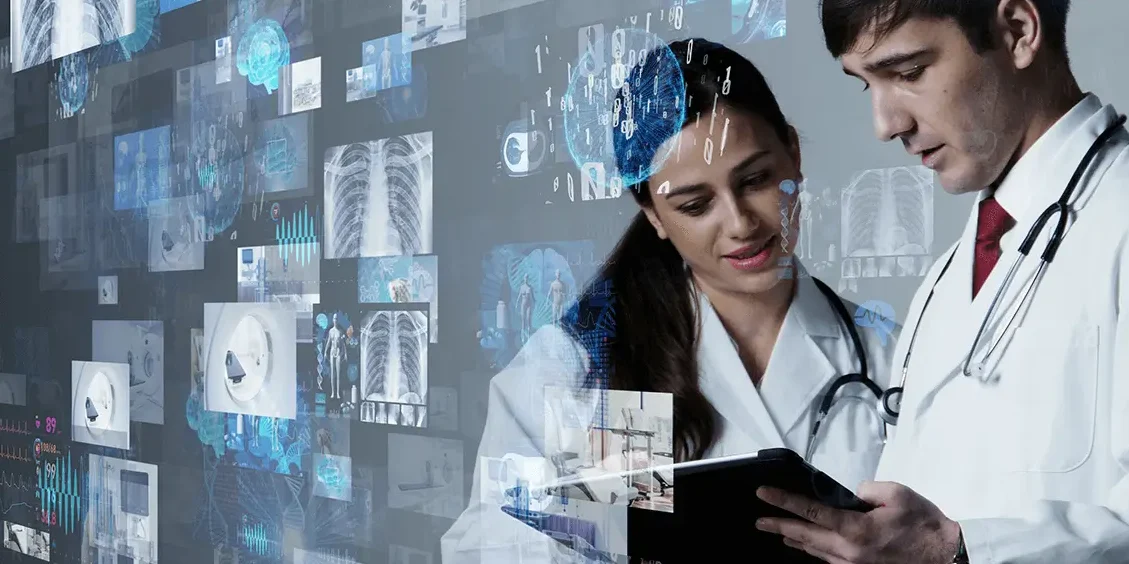Artificial intelligence (AI) in healthcare is not a new concept. In the 1970s, AI applications were first used to assist with biomedical problems and research. From there, AI-powered applications have expanded and adapted to transform the healthcare industry by reducing spend, improving patient outcomes, and increasing organizational and process efficiencies overall.
How AI Works
Before we get into the evolution of AI in healthcare, it is beneficial to understand how artificial intelligence works. Essentially, AI describes computer models and programs that imitate human-level intelligence to perform cognitive functions, like complex problem-solving and experience gathering.
Most current AI tools are considered “Narrow AI,” which means the technology can outperform humans in a narrowly defined task. Many current approaches are powered by machine learning algorithms. Machine learning enables computers to learn, perform tasks and adapt without human intervention.
The Origins of AI in Healthcare
The phrase “artificial intelligence” was first coined in a Dartmouth College conference proposal in 1955. But the AI applications did not enter the healthcare field until the early 1970s when research produced MYCIN, an AI program that helped identify blood infections treatments. The proliferation of AI research continued, and in 1979 the American Association for Artificial Intelligence was formed (currently the Association for the Advancement of Artificial Intelligence, AAAI).
Throughout the 1980s and 1990s, the design of new AI systems helped achieve medical advancements such as:
- Producing faster data collection and processing
- Assisting in more precise surgical procedures
- In–depth DBA research and mapping
- More comprehensive implementation of electronic health records
Where AI is Today
AI technology and machine learning have evolved to influence how healthcare is delivered profoundly. This advanced technology has evolved beyond biological sciences, where it began and now applies to medical specialties, including:
- Radiology
- Screening
- Psychiatry
- Primary Care
- Disease Diagnosis
- Telemedicine
AI-Driven Solutions for Utilization Review
While AI in healthcare has become prevalent, its introduction to utilization review and case management did not happen until recently.
Administrative burden, subjective data, and lack of payer-provider connectivity have always plagued utilization review, mostly due to a lack of technology that provides access and analysis. “Until a few years ago, a patient’s previous medical history wasn’t even considered in the utilization review process,” says Michelle Wyatt, Director of Clinical Best Practices at Xsolis.
Because of that, Michelle says so much complex patient information was missed. Artificial intelligence, such as Xsolis’ CORTEX platform, now know as Dragonfly Utilize, provides utilization review nurses the opportunity to understand patients better so their care can be managed appropriately to each specific case. Indeed, Xsolis’ platform was the first artificial intelligence-driven technology created specifically for the utilization review process.
How does it work? The Dragonfly Utilize platform extracts data from the electronic medical record, then applies natural language processing (which “reads” written documentation) and machine learning (which learns new patterns across millions of patients) so that UR teams can see a continuously updated and predictive view of each patient’s clinical picture. This allows for the case prioritization of patients, resulting in improved efficiencies.
Through Dragonfly Utilize, UR staff can share a comprehensive clinical picture of the patient with the payer/health plan, allowing both sides to see the exact same information at the same time. This shared data has helped to solve the contentious relationship that has plagued UR for so long.
Hospitals and health systems across the nation are taking advantage of the benefits AI provides, specifically to utilization review. Implementing this type of change is transformative and whether a barrier is fear of change, financial worries, or concern about outcomes, Xsolis helps clients overcome these concerns and realize significant benefits.
“Case managers often ask if AI will replace them in the future,” says Michelle. “I explain that artificial intelligence is a tool that allows us to understand the holistic nature of each patient better, but it doesn’t replace the expertise of a nurse or physician reviewer.”
Platforms leveraging Artificial intelligence allow UR nurses to automate all the manual data gathering that takes up so much time. That results in more time to manage patient care and put their clinical training to work.
Looking to the Future of AI in Healthcare
According to the World Economic Forum (WEF), the future of AI in healthcare will dramatically change between now and 2030 in the following three ways:
1. Connected Care
AI in healthcare will help detect patterns and connect systems. This will allow for a network of seamless sharing of data, to anywhere, from anywhere. This shared data and information will create life-saving connectivity across the globe.
2. Better AI-Powered Predictive Care
Improved data will evaluate the probability and risk of an individual developing a disease in the future.
3. Improved Patient and Staff Experiences
As AI evolves, it will continue to improve patient and provider experiences, including reducing wait times for patients and improved overall efficiency in hospitals and health systems. Hospitals are harnessing AI to do work uniquely suited to automation – and making time for humans to do the work they are uniquely suited to: providing exceptional patient care.
